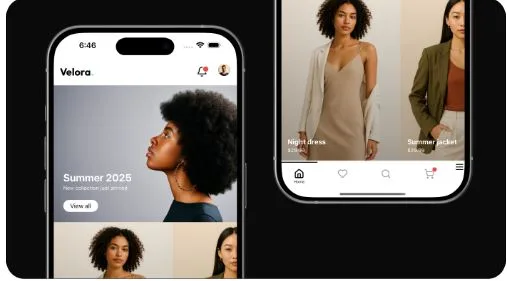Web Design in South Carolina: Why the Smartest Brands Are Skipping Templates in 2025
I’ve been in the web game for over two decades, and I can confidently say that web design in South Carolina has undergone a seismic shift in the past few years. And no, it’s not because some Silicon Valley guru dropped in for a keynote or because AI started drawing wireframes in its sleep. It’s because local brands — especially the smart ones — have figured something out: templates aren’t the future. They’re barely holding together the present.
Now, before some agency with a “Get Your Site in 30 Minutes!” banner comes for my neck, let’s get real. This isn’t about bashing tools like Wix or Squarespace (though I will, enthusiastically, in a bit). It’s about pointing out what businesses across South Carolina — from boutique retailers in Columbia to startups in Charleston — are quietly realising: cookie-cutter sites don’t cut it anymore.
And when they get tired of looking like every other competitor on the block? They come to us — Web Design Columbia, or WDC for short — because they want a digital presence that works.
Fast, Cheap, and Doomed: The Hidden Cost of Templates
Every day, I speak with business owners who started with the same goal: to get a website up quickly without spending a lot of money. They grab a flashy theme, maybe something from ThemeForest or a drag-and-drop builder that promised the moon. And for the first few days, it feels great — the site is live, the homepage is animated, and they can finally tell people, “Check us out online.”
Then the reality creeps in. The mobile version is a mess. The site loads like it’s on dial-up. Search engines ignore it. And the layout, though shiny, looks suspiciously similar to about 300 other small business websites — many of them in the same industry.
That excitement turns into frustration. They call us.
When the Lightbulb Goes On
The smartest business owners in South Carolina — the ones who dig into their analytics and care about growth — realise quickly that a template isn’t a business asset. It’s a limitation.
They start asking the right questions:
Why aren’t people converting?
Why do our competitors rank higher on Google?
Why does our website look outdated just a year after its launch?
That’s when they start thinking long-term. That’s when they understand that web design isn’t just about being online — it’s about being strategic.
A Real Story: Tina’s Transformation
Tina runs a home décor business in Greenville, South Carolina. When she first came to us, her Shopify template looked okay on a desktop monitor, but customers weren’t sticking around. Her bounce rate was over 80%. Mobile shoppers couldn’t find the cart. Product images loaded slowly, and checkout errors were common.
We didn’t try to “reskin” her site. We rebuilt it from scratch.
- We restructured her product pages for SEO
- We streamlined the mobile experience
- We reduced page load time by over 60%
- We also added custom checkout logic tailored to how her customers shop.
Within three months, she tripled her conversion rate. Her customers noticed. Google noticed. Tina hasn’t looked back.
Templates vs. Custom Design: The 2025 Checklist
Let’s pause for a moment and look at a side-by-side comparison.
| Feature | Templates | Custom Design (WDC style) |
| Speed Optimization | Poor (bloated with unused code) | Laser-focused and lightweight |
| Mobile Responsiveness | Often clunky | Tailored per device |
| SEO Readiness | Basic at best | Structured for growth |
| Scalability | Limited | Built to expand |
| Brand Identity Integration | Superficial | Deep, visual storytelling |
| Security & Maintenance | Generic plug-ins, often outdated | Ongoing, monitored, and secure |
| Cost in the Long Term | High (due to rebuilds, fixes, add-ons) | Lower (investment with ROI) |
This table is a daily reality check for many of our clients.
Designing for the South, Not the Globe
Here’s something most template designers don’t understand: South Carolina has its digital personality. Customers here behave differently from those in Manhattan or San Francisco. There’s a sense of community, loyalty, and a desire for clarity. Flashy gimmicks don’t work on a buyer who just wants to understand your product or call you without filling out a 12-step contact form.
That’s why Web Design Columbia always builds with regional awareness. We ask things that templates can’t ask. Is your audience older and less tech-savvy? Do they need accessibility options? Do you serve multilingual customers? Do most of your leads come through mobile search? Templates don’t care. We do.
The SEO Monster Under the Bed
We can’t talk about modern websites without talking about Google — and more importantly, how it judges your site.
Since 2024, Google’s algorithm updates have focused on Core Web Vitals, which include factors such as page load speed, stability during loading, and responsiveness to user input. Guess what? Most template-based sites fail these metrics from the outset.
They’re bloated with unused JavaScript. They often fail mobile performance audits. And they lack the structured data and semantic HTML that Google consumes with ease.
At WDC, we build sites that consistently score high in PageSpeed Insights and pass every Core Web Vitals check. And our clients rank higher, not because of luck, but because their site is built right.
The Quiet Rise of Columbia’s Design Scene
Let me tell you something you won’t hear in national tech blogs: Columbia is quietly becoming one of the most innovative spots for web design in the South. And no, it’s not just because the cost of living is lower — it’s because we care more about the craft.
We’ve worked with local nonprofits, startups, eCommerce shops, and even government initiatives. And one trend keeps repeating: the most successful clients are the ones who said no to pre-made designs and yes to strategy, quality, and originality.
Templates might seem like the easy route, but in 2025, they’re a ticking time bomb for SEO, for user engagement, and for brand differentiation.
What’s the Real Cost of That $59 Theme?
Let’s have a moment of honesty. That pre-built WordPress or Shopify template you found? It seemed like a steal. Sixty bucks. Maybe a hundred. Even a freelancer offered to “set it up” for under $500.
So why did it end up costing you three times that much in fixes, upgrades, SEO band-aids, and lost conversions?
I’ve had client after client tell me: “We just needed something simple.” And they meant it. But what they didn’t realize is that web design in South Carolina is no longer about launching something — it’s about building something that grows with your business.
And when your starter template cracks under pressure, you’re left with three options:
- Patch it endlessly
- Hire someone to customize the mess
- Burn it all down and start over (which is when they usually find us)
Let’s break down why that happens — and why skipping templates in the first place is often the most intelligent, most cost-effective decision a South Carolina business can make in 2025.
ROI Isn’t a Guess — It’s a Formula
At Web Design Columbia (WDC), we’ve worked with brands across industries — HVAC, medical clinics, nonprofits, artisan coffee shops — and in every case, we’ve seen the same pattern: a high-performing custom site delivers returns within months, often without requiring ad spend to get traction.
Why? Because when your site loads fast, speaks directly to your local audience, looks great on every screen, and shows up on Google’s first page, customers respond. Leads go up. Bounce rates go down. Your competitors wonder what happened.
If you’re spending $2,000–$3,000 up front on a custom-built site and gaining dozens more leads per month, how long before that investment pays for itself? Spoiler: not long.
Now compare that to a $500–$1,000 templated site that needs continual patching and loses leads daily. You’ll quickly realize: cheap gets expensive.
Why South Carolina Brands Are Choosing Local
Here’s something you won’t hear on Fiverr: understanding the South Carolina market matters.
We’ve worked with companies that previously hired overseas developers or used national agencies, with no understanding of how people search, scroll, or buy in Charleston, Columbia, or Myrtle Beach.
One client, a Columbia-based service provider, told us their old agency recommended a CTA that said “Book Your Free Consultation Now!” — which is great… for LinkedIn ads in New York. Not so much for someone skimming your site on an iPhone in a Food Lion parking lot.
South Carolina users are sharp, mobile-first, and tend to dislike being sold to aggressively. They prefer clarity, speed, and confidence. That’s why working with a local agency like Web Design Columbia means you’re not just building a site — you’re crafting an experience that fits your actual audience.
Custom Web Design: Not Just for Big Budgets Anymore
There’s a myth circulating that custom web design is reserved for the Fortune 500 crowd. And I’ll be blunt: that’s garbage.
Thanks to efficient development stacks, modular frameworks, and proper planning, we can build custom websites for small businesses that look and perform like enterprise platforms, without enterprise pricing.
What helps even more is that we avoid reinventing the wheel. We reuse what works, customize the rest, and focus on speed, clarity, and maintainability. That means lower ongoing costs and fewer surprises down the line.
And you don’t need a six-month runway to launch. We’ve built fully custom sites in 4–6 weeks with all the trimmings: optimized code, responsive layouts, SEO-friendly structure, and even built-in integrations with CRMs or booking tools.
How We Helped a Local Business Break the Cycle
Let me provide a real-world example. A Charleston-based tourism company came to us with a WordPress theme that was visually stunning, at least on desktop. But mobile performance was abysmal. Pages took 7 seconds to load. Google rankings were dropping. Their Facebook traffic wasn’t converting.
We stripped out the theme, rebuilt their layout using our own SC-optimized UX strategy, and layered it with a caching setup tailored for their regional traffic bursts.
In under six weeks, their average page load time dropped to under 1.5 seconds. Google Search Console showed a 33% increase in impressions. Conversion rate? Up 2.8×. And the best part? The business owner didn’t need a tutorial to manage it — we kept it simple.
If you think custom design is out of reach, remember this: the right team (ahem… WDC) will build around your needs, not around someone else’s one-size-fits-all theme.
Templates Aren’t Scalable — People Are
A huge mistake many businesses make is thinking a website is “done” after launch. But your offerings evolve, your customers grow, your messaging shifts — and your website has to move with you.
Templates don’t like that. They’re locked into grid systems and styling frameworks that crumble under change. Would you like to add a new pricing calculator? Good luck. Want to A/B test your product page design? Not unless you break it first.
With a properly built site from WDC, changes are easy because we create for flexibility from the start. Need a new section? We add it. Want to pivot your messaging for a seasonal campaign? Done. No hacks, no third-party workarounds.
See It Yourself
You don’t have to take my word for it. Visit us at webdesigncolumbia.us and see real websites built for real South Carolina businesses. You’ll see the difference instantly: pages that load fast, layouts that breathe, calls to action that feel natural, and designs that tell your story.
We don’t outsource, we don’t use cookie-cutters, and we don’t sell fantasy. What we offer is simple: solid websites, built for growth, designed for your market, and supported like you’re one of our own.
Your Website Isn’t a Poster — It’s a Platform
Templates pretend your site is a poster: it just needs to be there. But you know better.
Your website is where customers decide if you’re worth their time, money, and trust. It’s where Google decides whether you deserve that front-page spot. And it’s where your business either accelerates or stalls.
In 2025, web design in South Carolina isn’t about being online. It’s about being exceptional — locally relevant, technically solid, and endlessly scalable.
The most innovative brands are skipping templates, not because they’re flashy or rich. They’re skipping templates because they understand that in a fast-moving digital world, shortcuts are just delays in disguise.
If you’re ready to skip the template trap, we’re prepared to build something better together.





